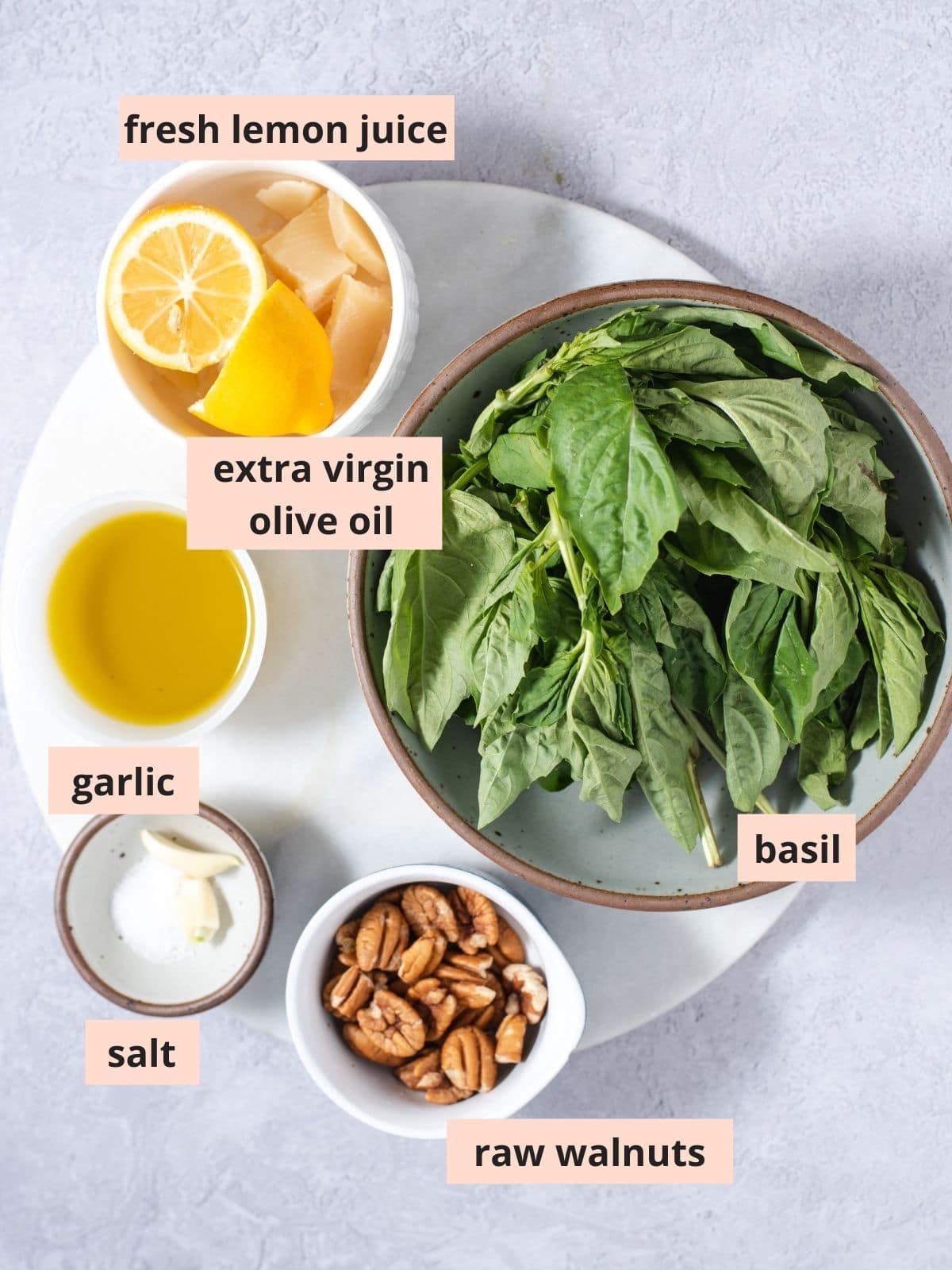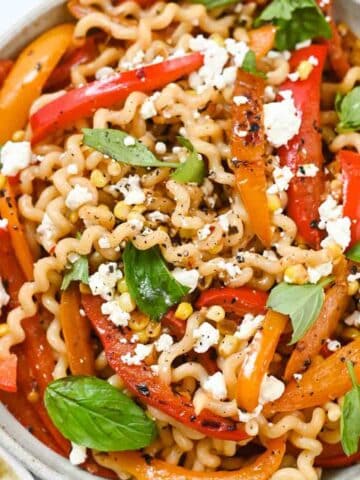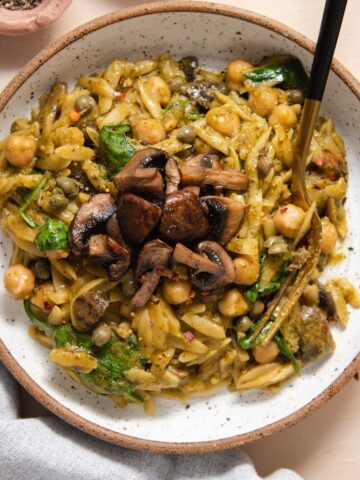This homemade pesto is the best way to use fresh basil in the summer! This recipe uses pecans instead of pine nuts for a simple twist on a classic pesto, but it can easily be made nut-free.

One of my favorite parts about having a summer garden is the abundance of fresh basil that inevitably gets turned into homemade pesto for pesto aioli, vegetarian pesto pasta, pesto orzo salad, and even a sauce for pita bread pizzas.
Because I don't really like pine nuts, I make pesto without pine nuts and with pecans instead. Pecans still add that the classic nutty texture and underlying flavor expected in pesto, but they have a more subtle flavor than pine nuts.
Jump to:
Recipe features
If you're new to making homemade pesto, here's what you need to know:
- Recipe time: Making homemade pesto is actually quick and easy to make. It takes just about 10 minutes, but it's quicker if you don't blanch the basil first.
- Equipment: Technically you can use a mortar and pestle, but a blender or food processor is the easiest way to go.
- Vivid green pesto: Blanching basil for pesto results in vivid green pesto instead of greenish-brown pesto. It sounds like a hassle, but it's completely worth it.
- Not quite nut-free: This recipe is made without pine nuts because I simply do not like the flavor and I prefer to use raw pecans or walnuts. You can omit nuts entirely for nut-free pesto.
Ingredients

- Basil: Italian large leaf basil and sweet basil are the most common variety of basil used for pesto and they are also the most common type of basil at the grocery store.
- Extra virgin olive oil: This contributes a lot of flavor to pesto, so choose EVOO with a flavor that you enjoy. Technically canola oil and other neutral oils can be used in pesto, but I think EVOO is worth the extra cost.
- Parmesan: A wedge of Parmesan has the best flavor, but shredded parmesan does work in a pinch. I often use a vegan Parmesan block to make dairy-free pesto.
- Pecans: This is not exactly a traditional pesto ingredient, but the nutty and rich flavor of pecans is a subtle addition to pesto. Raw walnuts are also a good option.
- Lemon juice is added for acidity and brightness. One medium lemon usually makes 2-3 tablespoons of lemon juice.
How to make pesto
Blanch the basil

I know, it seems like an annoying extra step, but I promise that it's worth it!
Blanching greens helps them preserve their vivid green color and results in a much more aesthetically pleasing pesto. If you don't care about that, feel free to skip this step.
To blanch basil, simply add the greens to boiling water for no more than 10 seconds. Using a slotted spoon, immediately transfer the basil to a large bowl filled with ice water.
Make the pesto

Don't add all of the pesto ingredients to the blender at once.
Start by adding the pecans, parmesan, garlic, and salt. Pulse to break down the pecans.
Add the basil and lemon juice. Turn the blender on medium speed. While it is on, slowly drizzle in the olive oil. This helps the pesto stays emulsified instead of separating.
Scrape down the sides of the blender as needed. Taste for salt, pepper, etc.
Storage and freezing
- Leftovers: Store leftover pesto in the fridge for up to a week.
- Freezing: Pesto freezes well! Simply freeze in an airtight jar or freezer container for up to 3 months. Let the jar thaw overnight in the fridge when ready to use.
Cooking tips
Add extra greens
I love adding spinach or arugula to pesto. It's not exactly traditional, but it's a great way to make more pesto when you're short on basil. I usually do equal parts basil and spinach.
Why is my pesto bitter?
Pesto can be bitter when too much raw garlic is added. I recommend starting with just one clove of garlic and tasting the pesto before adding more.
How to store fresh basil
Basil is a finicky herb when it comes to storage. Whatever you do, don't store basil in the fridge!
Instead, treat it like a flower bouquet. Trim the ends from the basil stems and place in a jar with just enough water to cover the bottom 1-2 inches of the stems. The water shouldn't touch the leaves or they will become slimy. Store at room temp.
Serving ideas
- Pesto aioli is a delicious addition to gyros and wraps. It's also great as a dip with fries or roasted sweet potatoes.
- Pesto pasta: I usually combine 6 ounces of pesto with 8 ounces of cooked pasta. Add a splash of the water that the pasta was cooked in for a thinner sauce. Or combine with avocados to make avocado pesto pasta.
- Use as a sauce on sqsuash and potato bowls and roasted veggies.
- Casseroles: I use this pesto to add flavor to my pesto rice bake and quinoa pesto bake.

Looking for more summer favorites?
Did you try this recipe? You can leave a star rating in the recipe card or a review in the comments below. Or check out my new cookbook and keep up to date with my YouTube, Instagram, TikTok, or newsletter!
📖 Recipe
Want to Save This Recipe?
Enter your email & I'll send it to your inbox. Plus, get great new recipes from me every week!
By submitting this form, you consent to receive emails from Cozy Peach Kitchen

Homemade Pesto Without Pine Nuts
Ingredients
- 2 cups basil leaves
- ⅓ cup raw pecans see note #1
- ¼ cup Parmesan see note #2
- 1 clove garlic adjust to taste
- 3 tablespoons lemon juice
- ¼ teaspoon kosher salt
- ⅓ cup extra virgin olive oil
Instructions
- Blanch the basil: Bring a small pot of water to a boil. Prepare a medium bowl with ice water. Add the basil to the boiling water for just 10 seconds. Use a slotted spoon to transfer the basil to the ice water.
- In a blender or food processor, pulse together the pecans, Parmesan, and garlic until mostly broken down.
- Add the basil, lemon juice, and salt. With the blender on medium speed, slowly drizzle in the olive oil.
- Scrape down the sides of the blender as needed. Taste for salt, garlic, and lemon juice. Enjoy!
Notes
- Pecans: Choose raw, unsalted pecans. An equal amount of walnuts also works. Simply omit the pecans to make this recipe nut-free.
- Parmesan: A wedge of roughly chopped Parmesan works best. Vegan parmesan works well to make this recipe dairy-free.
- This recipe makes about 1 cup (8 ounces) of pesto. Keep leftovers refrigerated in the fridge for up to 1 week, or freeze for up to 3 months. Let thaw overnight in the fridge when ready to use.










Comments
No Comments